Frequency modulation of synchronized Ca2+ spikes in cultured hippocampal networks through G-protein-coupled receptors
- PMID: 12764103
- PMCID: PMC6741069
- DOI: 10.1523/JNEUROSCI.23-10-04156.2003
Frequency modulation of synchronized Ca2+ spikes in cultured hippocampal networks through G-protein-coupled receptors
Abstract
Synchronized spontaneous Ca2+ spikes in networked neurons represent periodic burst firing of action potentials, which are believed to play a major role in the development and plasticity of neuronal circuitry. How these network activities are shaped and modulated by extrinsic factors during development, however, remains to be studied. Here we report that synchronized Ca2+ spikes among cultured hippocampal neurons can be modulated by two small factors that act on G-protein-coupled receptors (GPCRs): the neuropeptide PACAP (pituitary adenylate cyclase-activating polypeptide) and the chemokine SDF-1 (stromal cell-derived factor-1). PACAP effectively increases the frequency of the synchronized Ca2+ spikes when applied acutely; the PACAP potentiation of Ca2+ spikes requires the activation of the PACAP-specific PAC1 GPCRs and is mediated by the activation of cAMP signaling pathway. SDF-1, on the other hand, significantly reduces the frequency of these Ca2+ spikes through the activation of its specific GPCR CXCR4; the inhibitory action of SDF-1 is mediated by the inhibition of cAMP pathway through the Gi component of GPCRs. Taken together, these results demonstrate that synchronized neuronal network activity can be effectively modulated by physiologically and developmentally relevant small factors that act on GPCRs to target the cAMP pathway. Such modulation of neuronal activity through GPCRs may represent a significant mechanism that underlies the neuronal plasticity during neural development and functioning.
Figures
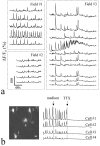
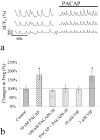
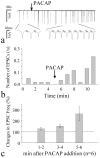

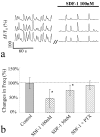
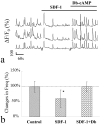
Similar articles
-
Modulation of AMPA receptor-mediated ion current by pituitary adenylate cyclase-activating polypeptide (PACAP) in CA1 pyramidal neurons from rat hippocampus.Hippocampus. 2009 Jan;19(1):99-109. doi: 10.1002/hipo.20488. Hippocampus. 2009. PMID: 18727050
-
Pituitary adenylate cyclase-activating polypeptide potentiation of Ca2+ entry via protein kinase C and A pathways in melanotrophs of the pituitary pars intermedia of rats.Endocrinology. 1997 Oct;138(10):4086-95. doi: 10.1210/endo.138.10.5442. Endocrinology. 1997. PMID: 9322916
-
Convergent phosphomodulation of the major neuronal dendritic potassium channel Kv4.2 by pituitary adenylate cyclase-activating polypeptide.Neuropharmacology. 2016 Feb;101:291-308. doi: 10.1016/j.neuropharm.2015.10.006. Epub 2015 Oct 9. Neuropharmacology. 2016. PMID: 26456351 Free PMC article.
-
Pituitary adenylate cyclase-activating polypeptide (PACAP) and its receptors in the brain.Kaibogaku Zasshi. 2000 Dec;75(6):487-507. Kaibogaku Zasshi. 2000. PMID: 11197592 Review.
-
Perspectives on pituitary adenylate cyclase activating polypeptide (PACAP) in the neuroendocrine, endocrine, and nervous systems.Jpn J Physiol. 1998 Oct;48(5):301-31. doi: 10.2170/jjphysiol.48.301. Jpn J Physiol. 1998. PMID: 9852340 Review.
Cited by
-
The regulation of M1 muscarinic acetylcholine receptor desensitization by synaptic activity in cultured hippocampal neurons.J Neurochem. 2007 Dec;103(6):2268-80. doi: 10.1111/j.1471-4159.2007.04931.x. Epub 2007 Oct 1. J Neurochem. 2007. PMID: 17908240 Free PMC article.
-
Imaging cytoplasmic cAMP in mouse brainstem neurons.BMC Neurosci. 2009 Mar 27;10:29. doi: 10.1186/1471-2202-10-29. BMC Neurosci. 2009. PMID: 19327133 Free PMC article.
-
Localization of CXCR4 in the forebrain of the adult rat.Brain Res. 2010 Feb 22;1315:53-62. doi: 10.1016/j.brainres.2009.12.015. Epub 2009 Dec 21. Brain Res. 2010. PMID: 20026091 Free PMC article.
-
Expression profiling reveals differential gene induction underlying specific and non-specific memory for pheromones in mice.Neurochem Int. 2011 Nov;59(6):787-803. doi: 10.1016/j.neuint.2011.08.009. Epub 2011 Aug 23. Neurochem Int. 2011. PMID: 21884744 Free PMC article.
-
DREAM mediates cAMP-dependent, Ca2+-induced stimulation of GFAP gene expression and regulates cortical astrogliogenesis.J Neurosci. 2008 Jun 25;28(26):6703-13. doi: 10.1523/JNEUROSCI.0215-08.2008. J Neurosci. 2008. PMID: 18579744 Free PMC article.
References
-
- Abel T, Kandel E ( 1998) Positive and negative regulatory mechanisms that mediate long-term memory storage. Brain Res Brain Res Rev 26: 360–378. - PubMed
-
- Anholt RR ( 1994) Signal integration in the nervous system: adenylate cyclases as molecular coincidence detectors. Trends Neurosci 17: 37–41. - PubMed
-
- Asensio VC, Campbell IL ( 1999) Chemokines in the CNS: plurifunctional mediators in diverse states. Trends Neurosci 22: 504–512. - PubMed
-
- Bacci A, Verderio C, Pravettoni E, Matteoli M ( 1999) Synaptic and intrinsic mechanisms shape synchronous oscillations in hippocampal neurons in culture. Eur J Neurosci 11: 389–397. - PubMed
-
- Banker GA, Cowan WM ( 1977) Rat hippocampal neurons in dispersed cell culture. Brain Res 126: 397–425. - PubMed
Publication types
MeSH terms
Substances
LinkOut - more resources
Full Text Sources
Miscellaneous
